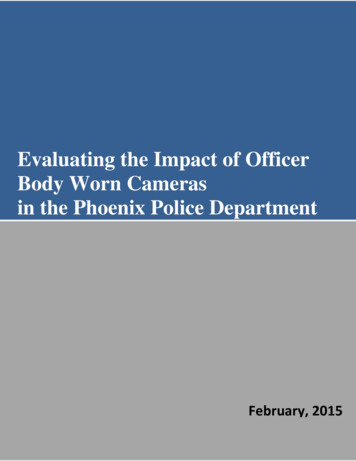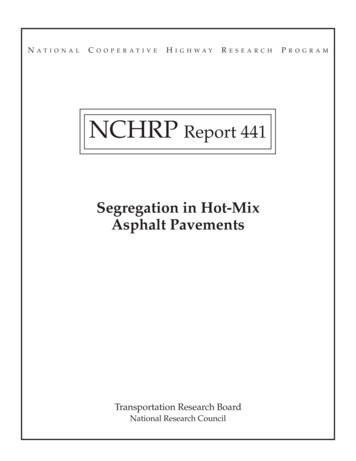
Transcription
Evaluating the Impact of OfficerBody Worn Camerasin the Phoenix Police DepartmentFebruary, 2015
Evaluating the Impact of Officer Worn Body Camerasin the Phoenix Police DepartmentbyCharles M. Katz, Ph.D.David E. Choate, M.A.Justin R. Ready, Ph.D.Lidia Nuño, M.S.Arizona State UniversitywithCommander Mike KurtenbachSergeant Kevin “K.J.” JohnsonPhoenix Police DepartmentDecember 2014Suggested citation:Katz, Charles M., David E. Choate, Justin R. Ready, & Lidia Nuño. (2014). Evaluating theImpact of Officer Worn Body Cameras in the Phoenix Police Department. Phoenix, AZ: Centerfor Violence Prevention & Community Safety, Arizona State University.1
TABLE OF CONTENTSSECTIONPageEXECUTIVE SUMMARY3INTRODUCTIONCameras and PolicingThe Present Study447METHODSSettingProject Design and Analytic ApproachDataProject meeting minutes and notesKey stakeholder interviewsCAD/RMS DataCamera metadataOfficial complaint dataOfficer self-report surveyDomestic Violence Pocket Card DataOfficial Phoenix City court dataLimitations888991010101111121212PROCUREMENT AND ACQUISITION OF THE TECHNOLOGYThe SolicitationTesting the Device131415TRAINING AND IMPLEMENTATIONActivation Compliance and Use of Body Worn Video CamerasUse of Body Worn cameras by Incident Type171720OFFICER PERCEPTIONS OF BODY WORN CAMERAS23IMPACT OF BODY WORN CAMERAS ON ARREST31IMPACT OF BODY WORN CAMERAS ON OFFICER MISCONDUCT33AND COMPLAINT RESOLUTIONIMPACT OF BODY WORN CAMERAS ON DOMESTIC VIOLENCE CASE PROCESSING37CONCLUSIONS AND LESSONS LEARNEDMajor FindingsLessons Learned4040412
EXECUTIVE SUMMARYThe Bureau of Justice Assistance (BJA), through the SMART Policing Initiative (SPI), awarded the PhoenixPolice Department 500,000 to purchase, deploy and evaluate police body worn cameras. The designand implementation of the project included the purchase of 56 BWC systems and deploying them in theMaryvale Precinct. The implementation of the BWC’s occurred in one of the two Maryvale Precinctsquad areas (aka target area). All officers assigned to the target area were issued the equipment andwere provided training in its use, maintenance, and related departmental policy. This evaluation wasconducted to examine the effect of implementing police worn body cameras on complaints against thepolice and domestic violence case processing and outcomes.Our analysis of the camera meta-data indicated that only 13.2 to 42.2 percent of incidents wererecorded by and BWV camera. Domestic violence incidents were the most likely to be recorded (47.5%),followed by violent offenses (38.7), back-up (37%), status offenses (32.9%), and subject/vehicle stops(30.9%). Other offense types were recorded less often. While in general the technology was found to becomfortable and easy to use, officers were dissatisfied with long down load times, increased amount oftime that it took to complete reports, and the possibility that video recordings might be used againstthem by the department. We also found that video submitted to the court was difficult to processbecause of logistical problems associated with chain of custody and the length of time that it took theprosecutors to review video files. While many of the problems were addressed by the precinctcommander by assigning a police officer to serve as a court liaison officer, prosecutors still maintainedthat they did not have enough time to review video footage.Regardless, the officer worn body cameras were found to be beneficial to the officers and the court in anumber of ways. First, officer productivity as measured through the number of arrests increasedsignificantly. For instance, the number of arrests increased by about 17% among the target groupcompared to 9% in the comparison group. Second, complaints against the police declined significantly.Complaints against officers who wore the cameras declined by 23%, compared to a 10.6% increaseamong comparison officers and 45.1% increase among patrol officers in other precincts. Third, our datashowed that those officers who wore cameras and received a complaint were significantly less likely tohave the complaint sustained when compared to the comparison group and other patrol officersthroughout the PPD. This suggests that even if a complaint was made against a camera wearing officerthe video file was likely to provide support to the officer. Fourth, and related, the officer self-reportdata suggested that a significant number of complaints were not pursued because of video recordings.BWC did not appear, however, to have an impact on suspect behavior as measured through resistingarrest charges.Additionally, we examined the impact of body worn cameras on domestic violence case processing.Analysis of the data indicated that following the implementation of body cameras, cases weresignificantly more likely to be initiated, result in charges filed, and result in a guilty plea or guilty verdict.The analysis also determined that cases were completed faster following the implementation of bodycameras, however, we believe that this finding was largely a product of the addition of a court liaisonofficer who facilitated case processing between the PPD and city prosecutors office.3
SECTION 1: INTRODUCTIONThe Bureau of Justice Assistance (BJA) awarded funding to the Phoenix Police Department(PPD) to purchase, deploy and evaluate on-person video cameras that record the interactionsbetween community members (e.g., the public, suspects and victims) and officers. The camera isworn on the officer’s uniform, placed optionally on the shoulder lapel or upper placket, with aforward-facing viewable area. The camera captures events and interactions that take placebetween suspects, victims, and the officer. The video recordings can be used by the police todocument statements, observations, behaviors and other evidence; and can simultaneously beused to prevent and deter unprofessional, illegal, and inappropriate behaviors by both the policeand the public. Accordingly, this technology can be used to resolve disputes and build trust withthe community by preserving a record of critical events.The technology for the present project was primarily selected for two purposes: 1) to increasepolice accountability; and 2) increase the effectiveness of the police in their response to crime ingeneral and domestic violence specifically. First, the technology might deter officers fromengaging in unprofessional behavior or misconduct, and similarly, deter members of the publicfrom inappropriate, aggressive or resistant behavior. Furthermore, with respect to policeaccountability the technology has the potential to record misconduct, use of force, and otherproblem behavior or unprofessional conduct; and, conversely it has the potential to be used by anofficer to disprove an allegation of misbehavior and may defuse potentially violent interactionsbetween the police and the community. As a consequence, we believed that such technologymight increase accountability among the public and the police, decrease citizen complaints, andresult in increased perceptions of legitimacy, trust, and public satisfaction with the police. Webelieve that an ancillary benefit of the technology is that it might reduce civil judgments againstthe city as a result of injuries or damage that might occur as a consequence of police misconductor false claims about police misconduct.Second, the technology has the potential to increase the effectiveness of the police response tocrime in general and domestic violence specifically. Regular recording of officer-involvedincidents might improve the level of recollection of the incidents when the officer is completingtheir field reports, and later during court proceedings. The video can be entered into evidence asfurther proof of the incident, which has the potential of leading to higher rates of arrest, charging,prosecution, and conviction. We were also interested in determining whether the technologyincreased public cooperation with the police. Cooperation was measured by examining the use ofthe technology and its effect on deterring individuals from committing secondary violations suchas resisting arrest, assaulting a police officer, and trying to escape.Cameras and PolicingThe television show Cops first aired in 1989, and continues as one of the longest running showson television. The American public’s familiarity with seeing police work on video is engrained,but this is still an external observer with a camera, recording events for the purpose of producinga television show. As video recording technology advanced sufficiently to allow for compactdevices that could fit on a patrol car’s dashboard without significantly interfering with ordinaryresponsibilities, police departments began to adopt dashboard cameras. Through the 1990’s andearly 2000’s the U.S. Department of Justice’s Office of Community Oriented Policing Services4
(COPS) In-Car Camera Program provided millions of dollars in grants to purchase and deploydashboard cameras to law enforcement agencies across the country (Fiumara, 2012). Dashboardcameras have been demonstrated to improve officer safety and accountability. In part because ofthis, they have been widely adopted and accepted by law enforcement agencies and officers overthe past few decades (International Association of Chiefs of Police [IACP], 2004).More recent technological developments in the portability of devices with video recordingcapability have renewed the discussion about cameras in policing. On-officer, body worn video(BWC) camera devices are an emerging technology, lauded for their contribution to policeaccountability and transparency, as well as their evidentiary value, an increasing number ofpolice departments are deploying them, if not wholesale, in a limited capacity (White, 2014).Critics of BWC cite privacy concerns and unnecessary expenses. Despite the exponential growthin the number of agencies purchasing and deploying BWC, there is still little empirical evidenceto support the claims of their supporters, or understand their unintended consequences. To date,only five (5) empirical studies have examined the impact of BWC and the process of theirimplementation.In 2006, the constabulary in Plymouth, UK conducted a 17-month study using 50 BWC (Policeand Crime Standards Directorate, UK Home Office, 2007). The BWC relied on a headband tomount the camera just above the officer’s left ear. More than 300 officers were trained for theuse of the BWC, and were allowed to voluntarily checkout and use the system at theirconvenience. Key findings of the study included: increased evidentiary quality; 22.4% less timespent on paperwork; substantial support in domestic violence cases; advantages in professionaldevelopment and officer accountability; and cost constraints. Improvement in the quality ofevidence was demonstrated by increases in charges/summons (10.2% to 15.0%), increases insanction detections (29.0% to 36.8%), and increased conversion of a violent incident into achargeable crime (71.8% to 81.7%). In one domestic violence case, the video evidence receivedinternational press attention following its use in the conviction of the suspect. Complaints againstofficers declined by 14.3% overall, and none were filled against officers who wore the cameras.Despite these advantages, the BWC systems proved to be too costly to continue and expand.Another BWC evaluation was conducted in Victoria, British Columbia, Canada from July 1,2009 through October 30, 2009 (Victoria Police Department (VPD), 2010). The department usedfour head-mounted BWC, available for voluntary use primarily by foot and bicycle patrolofficers. Similarly to the Plymouth, UK study, no officers wearing the cameras in Victoria had acomplaint filed against them. Unlike Plymouth, Victoria officers reported spending more timecompleting paperwork where video evidence was included. The majority (80%) of Victoria PDofficers reported that the BWC evidence provided a more accurate account of the incident and87% felt that the video improved the quality of evidence. While the evidence was usable in court,the study recommended the use of a liaison with the court to address processing concerns. Thestudy further found that the approval rate for submitted charges increased from 84% to 93%.Officers’ awareness of their environment also improved with the use of the camera. One of theconcerns cited by the study was data security, but also determined that this was a surmountableproblem. As a feasibility study for the VPD, it was determined that the benefits of BWCoutweigh their limitations, and that the adoption of the technology was appropriate and desirablefor the agency.5
Two communities in Scotland conducted studies in the use of BWC. In Renfrewshire, 38cameras were deployed for eight months in 2008-2009 and in Aberdeen 18 cameras (laterincreased to 30) were studied over a three month period beginning June 1, 2010. The study foundsubstantial declines in crime in the areas where the BWC were deployed. Specifically, the studyreported that breach of peace offenses declined 19%, vandalism 29%, minor assaults 27%, andserious assaults declined 60%, for an overall decline in crime of 26% (ODS Consulting, 2011).Additionally, the study found that in Renfrewshire BWC cases were processed to guiltypleas/verdicts faster that those outside the study period. About 39% of BWC cases were settled atthe earliest possible stage, compared to 37% and 29% among all other (non-BWC) cases in thetwo relevant court jurisdictions, and only 4% of BWC cases advanced to trial, compared to 1420% of non-BWC cases. In Aberdeen the results were more pronounced. BWC cases inAberdeen were settled by guilty plea at the earliest possible stage 85% of the time, compared to18% of non-BWC cases. Furthermore, the remaining 15% of BWC cases ended in guilty pleas,with none proceeding to trial. The BWC also demonstrated effectiveness in addressing citizencomplaints against officers. Among the two sites, there were only seven complaints made againstofficers wearing a BWC, among more than 5,000 contacts during the study period. Three of theseven were unfounded after an initial review of the video, requiring no further action, and theother four substantiated the officer accounts and cleared them of any misconduct orunprofessional behavior. Finally, the study reported declines in assaults against officers wearingBWC. In Aberdeen for example, about 30% of officers at any given time would have beenwearing a BWC during the study period. During that time, there was only one assault against anofficer wearing a BWC, compared to 61 assaults on officers who had not worn the device.In the Rialto, California Police Department (RPD), BWC were deployed for 12 monthsbeginning in February 2012. At the time of the study, the RPD identified 54 frontline officerswho would be eligible to wear the BWC. The officers were randomly assigned by shift to eitherwear (i.e. treatment) or not wear (i.e. control) the BWC on a weekly basis. Over the course of thestudy period, this method yielded 489 treatment shifts and 499 control shifts were observed. Theresults were favorable for the use of BWC. The study found that citizen complaints dropped by88%, from 28 complaints in the year prior to just 3 complaints during implementation. Therewere 61 use of force incidents before implementation, which declined by 60% to 25 incidentsduring the implementation period. Additionally, control shifts saw double the number of use offorce incidents than treatment shifts during the same period. Finally, the cameras did not have anadverse impact on the frequency of police-public contacts. The RPD recorded 40,111 policepublic contacts in the year prior to implementation, and 43,285 during the year ofimplementation. (See Ariel, Farrar & Sutherland, 2014).Most recently, an evaluation of BWC was conducted on their use in Mesa (AZ) PoliceDepartment (MPD). The MPD purchased 50 cameras, deployed to 25 officers who volunteeredfor the study and 25 randomly selected officers. Additionally, another 50 officers were tracked asa control group for the BWC intervention. During the first six months, officers were directed toactivate the cameras during contacts with the public and when practical. During the second sixmonths of the study, officers were encouraged to use the BWC, but were permitted to use themat their discretion. During the required use period, there were 2,327 BWC activations, whichdeclined 42% (n 1,353) during the discretionary use period. The study found 60% fewer citizen6
complaints among officers wearing the BWC, when compared to the non-BWC control officers.Some BWC problems were also identified in the Mesa study. Specifically, there were 3 to 4requests for video redaction over the study period, which required an average of 10 hours oflabor per request. This was a largely unanticipated resource cost above the approximate 67,000spent on buying the BWC units (at 800- 1,000 each) and affiliated operational costs for theone-year study period. By the end of the study period, still only 23% of MPD BWC usersbelieved that the cameras should be permanently adopted department-wide. (See Mesa PoliceDepartment, 2013).The Present StudyThe camera technology for the project, as initially proposed, was primarily intended for twopurposes: 1) to increase police accountability; and 2) increase the effectiveness of the police intheir response to domestic violence. The present study sought to assess each of these originallyintended goals, but also sought to examine the potential impact on officer performance, both inthe adoption of, and adaptation to the body worn camera technology, and to assess the impact ofcameras on officer job performance and satisfaction. The present study thus examined the effectof the body worn camera technology in six principal areas: 1) officer camera activationcompliance; 2) utility and use of body worn cameras; 3) impact on officers’ job performance; 4)impact on public compliance and cooperation; 5) impact on officer accountability; and 6) impacton domestic violence case processing and outcomes.7
SECTION 2: METHODOLOGYSettingThe Phoenix Police Department (PPD) is a large municipal police agency, with more than 3,000authorized sworn personnel, and serves a community of more than 1.5 million people; making itthe sixth largest city in the U.S. The PPD is organizationally divided into precincts and beat areasfor principal patrol services. At the time of the study, the PPD’s patrol division was divided intoeight precincts. Most precincts were divided into three beat areas, the Maryvale Precinct wasone of three which was divided into two areas. The Maryvale Precinct is approximately 15square miles, and is operationally and geographically divided into two similarly sized patrolareas. Each of the two areas is assigned six patrol squads to provide first response coverage tocalls for service on a twenty-four hour basis, seven days a week. While small changes in staffingoccurred throughout the study, generally there were between 100 and 110 patrol officers equallydivided between Areas 81 (comparison) and 82 (target).The community characteristics of the study setting were important to the site selection for thestudy. The community served by the precinct has a population of about 105,000 residents, and isprimarily comprised of Hispanic residents who are poorer and more likely to be unemployedthan residents living in other areas in the city. Maryvale has historically been and continues to bea location for a high-volume of police activity, calls for service, and elevated crime rates,particularly for violent crime, relative to other areas in the city. In 2010, the UCR violent crimerate for Maryvale was approximately 85 crimes per 10,000 residents, compared to 55 per 10,000for the rest of the city. Domestic violence is also a recurring problem in this precinct. In 2010,there were more than 3,300 calls for service that were initially dispatched as domestic violenceincidents in Maryvale Precinct. The organizational structure, combined with the historicallyhigher than citywide average crime rates lead to the Maryvale Precinct being selected as the sitefor the proposed quasi-experimental design for the body worn camera project.Project Design and Analytical ApproachThe design and implementation of the project included the purchase of 56 camera systems anddeploying them in the Maryvale Precinct. The implementation of the VIEVU camera systemoccurred in one of the two Maryvale Precinct squad areas, Area 82. This group was referred to asthe target group, or as the camera officers. The equipment provided for simultaneous coverage(using the system) seven days of the week, during all three shifts, by all deployed officers, andallowed for all officers to download data prior to next shift. All officers assigned to the sixsquads in the target area were issued the equipment and were provided training in its use andmaintenance through a coordinated effort led by the precinct commander and VIEVU.Departmental policy involving the use of the cameras was formulated prior to implementationand was also an integral part of the training by the PPD.Analysis of data for the present study relied on a pre-post comparison between target andcomparison groups. The pre-post camera deployment analyses typically relied on data fromJanuary 1, 2012 through July 31, 2014. The cameras were deployed in the field on April 15,2013. The study period covered about 134 total weeks, or 67 weeks pre camera deployment and67 weeks post camera deployment, generally truncated in text to 15 months. We also comparedofficers in one area (Area 82) who were assigned to wear BWC, to officers in another area (Area8
81) who were not assigned to wear BWC. As discussed previously, the Maryvale Precinct isdivided into two patrol areas. Given this organizational structure, the two areas had the samecommand structure, and the same shift assignment and schedule. During the project planningphase the two areas were examined for differences in the community’s they served. As observedbelow we found some differences between the two with respect to population, socio-economiccharacteristics, domestic violence, and crime.Exhibit 1: Characteristics of target and comparison areasCharacteristicTotal PopulationAge% Under 18 yearsEthnicity% Hispanic% Native American% African AmericanPovertyMean household income% owner occupiedNumber of Officially Reported Crimes (UCR)-Jan-Nov.2011ViolencePropertyTotalDomestic violenceCFSGeographic size (Square miles)Target AreaArea 8256,630Comparison AreaArea 8171,67643.1339.4582.51.33.971.11.36.4 44,89552.8 Data for the present study relied on stakeholder interviews, project planning documents, camerametadata generated by camera activation, officer self-report surveys, official police computeraided dispatch and record management system (CAD/RMS) data, official complaints and reportsof misconduct reported to the PPD, and official case processing data from the City of PhoenixPolice Department and Prosecutor’s Office. Each of the data sources used for the present study isdiscussed below.Project meeting minutes and notes. Project meetings were held during the planning of theproject, camera acquisition, project implementation and ongoing activities. A critical review ofthese meetings’ minutes provided data for the evaluation. The meetings involved the discussionof the final assignment of the target and comparison areas, technology procurement and selectionprocess, development of camera use policy, and the handling and use of the audio-video datacreated as evidence for prosecutors. These observations and documents were used to assessproject activity, planning, implementation and policy development. By the end of the studyperiod several dozen meeting minutes and notes had been collected.9
Key stakeholder interviews. Interviews with key stakeholders were conducted to betterdescribe and understand the process of camera acquisition, selection, policy development andactual use and utility of the technology across the criminal justice system. The open-endedinterview approach allowed for stakeholders to provide information most important or relevantfrom their individual perspective, without limiting it through a bounded set of survey questions.Key stakeholders included PPD finance and budget personnel, PPD and City of Phoenixinformation technology staff, police-court evidence liaisons, PPD command staff, patrol officers,officers who field-tested the technology, and city and county prosecutors. More than 24interviews with key stakeholders were conducted over the study periodCAD/RMS data. CAD/RMS data from January 1, 2012 through July 31, 2014 were obtainedfrom the PPD for the purpose of evaluating the project. Data included all unique incident reportsfrom the Maryvale precinct to determine crime and disorder events pre and post cameraimplementation, by target and comparison area. These data included officer activity logs, whichare obtained through dispatch records when officers report status changes. These data were usedto analyze camera activation compliance by matching police activity with the camera meta-data(described below) and calculating the ratio of the number of incidents to the number of BWCrecords. These data included 81,257 incident entries for the Maryvale Precinct, about 48%(n 38,094) of which were attributed to a camera-wearing officer as the primary responding unit.The CAD/RMS data included records of all arrests made by officers assigned to the MaryvalePrecinct at some point during the analysis period. Due to data limitations, the date range for thearrest analysis was from January 1, 2012 through January 10, 2014, allowing 470 days pre and270 days post BWC deployment for analyses. These data were provided in their original form asboth incident-based and officer- based, and were converted for analysis within our researchdesign focusing on pre-post deployment and camera/comparison assignment. The data wereanalyzed to assess the impact of the technology on arrest. These same data were used to analyzechanges in the public’s willingness to cooperate with an officer through analysis of resistingarrest (i.e., flight, passive and use of force resistance, and aggravated assaults against officersduring the incident). The original arrest data contained information on 10,591 arrests, reduced to4,586 for analysis following removal of ineligible arrests (due to date, officer or arearestrictions). The data included the arrest charges, arresting officer(s) serial numbers and dateand time of event. These data were converted into an average daily arrest rate for each officeraccording to their specific assignment at the time of the event, as related to camera orcomparison group assignment.Camera metadata. Camera metadata was automatically generated by the camera technology.These data included the camera serial number, the officer to whom it was assigned, date/timestamps of activation and deactivation, length of recordings, and freeform data entered by usersthat briefly described the nature or important details of the recording (e.g. departmental reportnumber, accidental activation, relevant information about the recording). The camera metadatagenerated by the VIEVU system was made available in its entirety, and included 17,023individual video files created over an 11-month period; beginning with the first day of activedeployment, April 15, 2013, through March 12, 2014, which was the most recently available dataat the time of request. Measures used for analyses included the description of the type ofactivation (e.g. incident recording, accidental activation, testing), the length of the recording, and10
whether the video file was attributed to a particular incident number. Additionally, those videofiles tagged with an incident number were linked to official CAD/RMS incident data to measurerates of compliance, and activations by incident type.Official complaint data. Department wide official complaint data were gathered from PPD’sProfessional Standards Bureau (PSB) for all sworn officers from January 1, 2012 through July31, 2014. These data included all complaints, regardless of the source of the complaint’sinitiation (e.g. citizen, officer’s supervisor, complaint hotline). The data identified the officer, theofficer’s assignment at the time of complaint, the disposition of the investigation (e.g. founded,unfounded, suspension), and a narrative of the incident. Included in the narrative was whetherbody-camera video was reviewed as part of the investigation. The complaint data were used toexamine the mean change in the number of complaints, and disposition of the complaints, prepost-test by target and comparison group.The complaint data initially included 2,919 cases. We first removed 496 cases from the analysisfile because no name or identifying information was known to PSB (e.g. some cases reported toPPD concerned non-PPD police officers). We next removed 160 cases from the dataset becausethey were only associated with internal inspections (e.g. uniform policy violations). Finally,another 123 cases were removed from the analysis because they were related to personnel otherthan patrol officers, who were the focus of the present study. In the end, the final datasetcontained 2,140 complaints. The measures created from these data were the number ofcomplaints made against each officer, whether or not the complaint was “founded” or not, andany disciplinary action taken against the officer. The PPD uses “founded” and “unfounded” toclassify complaints into one of two categories that essentially delineates whether or not anymisconduct occurred based on the accusation.Officer self-report survey. Perception surveys were anonymously completed by target andcomparison group officers, and were collected eight times throughout the course of the study:four
Phoenix Police Department December 2014 Suggested citation: Katz, Charles M., David E. Choate, Justin R. Ready, & Lidia Nuño. (2014). Evaluating the Impact of Officer Worn Body Cameras in the Phoenix Police Department. Phoenix, AZ: Center for Violence Prevention & Community Safety, Arizona State University.










